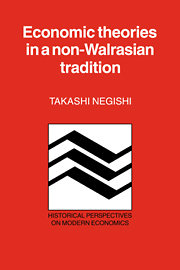Book contents
- Frontmatter
- Contents
- Preface
- 1 Anti-neoclassical or non-Walrasian economic theories
- Part I Increasing returns and diminishing cost
- Part II Wages and profit
- Part III International trade and investment
- Part IV Markets and money
- 12 Jevons, Edgeworth, and the competitive equilibrium of exchange
- 13 Menger's Absatzfähigkeit, a non-Walrasian theory of markets and money
- 14 The Marshallian foundation of macroeconomic theories
- Notes
- References
- Author index
- Subject index
14 - The Marshallian foundation of macroeconomic theories
from Part IV - Markets and money
Published online by Cambridge University Press: 21 September 2009
- Frontmatter
- Contents
- Preface
- 1 Anti-neoclassical or non-Walrasian economic theories
- Part I Increasing returns and diminishing cost
- Part II Wages and profit
- Part III International trade and investment
- Part IV Markets and money
- 12 Jevons, Edgeworth, and the competitive equilibrium of exchange
- 13 Menger's Absatzfähigkeit, a non-Walrasian theory of markets and money
- 14 The Marshallian foundation of macroeconomic theories
- Notes
- References
- Author index
- Subject index
Summary
The aim of macroeconomics is, particularly after Keynes's General theory, to explain changes in the aggregate output or employment as well as those in price level. Currently, we have two competing theories of macroeconomics: the monetarists' equilibrium theory and Keynesian disequilibrium theory. The former revives the traditional quantity theory of money and emphasizes the importance of changes in absolute price level, but extends the quantity theory so as to explain changes in aggregate output and employment, induced by changes in prices, while the latter claims the existence of involuntary unemployment and argues that changes in the effective demand induce changes in aggregate output and employment. The aim of this chapter is to consider how microeconomically such changes in aggregate output and employment can be explained in monetarist as well as in Keynesian theories.
Microeconomics, or price theory, is currently dominated by Walrasian theory, in which the real theory and monetary theory can be dichotomized and money can be neutral. Such a possibility of dichotomy and neutrality is, as we shall see, a necessary consequence of Walrasian procedure, in which an abstract nonmonetary real economic system is first considered before money is introduced into consideration. No one can deny the fact that in this way we can see better, in a sense, the working of the real economic forces hidden behind the monetary curtain of contemporary economy. We have nevertheless to pay the cost, because the role of money is extremely limited in the Walrasian system.
- Type
- Chapter
- Information
- Economic Theories in a Non-Walrasian Tradition , pp. 169 - 181Publisher: Cambridge University PressPrint publication year: 1985

